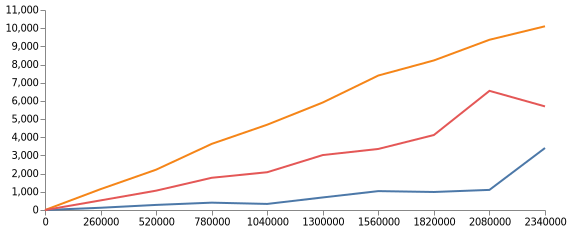This is an implementation of deep proxy with a twist. Unlike the most popular deep proxy package out there this one caches nested proxies and avoids regenerating them on each get. There are also some additional features which come in handy, like:
- History tracking and navigation
- Global keys
- Custom trap handlers
- Special modes like skip history, batch changes, quick access and more.
- Object change signalling without new references
This is a graph showing the difference in milliseconds (y axis) needed to perform various number (x axis) of sets, gets and deletes (orange, blue and red, respectively) between an object created with this package and a regular one.
This one measures the same thing but without history tracking
This package is obviously not meant to be used in situations requiring outstanding read and write performance. It has been developed primarily for a GUI object editor and many of the existing features stem directly from this use-case. If you want to perform millions of operations, do not use this package.
Change tracking was implemented in order to enable using this package with React. It was also done due to a need of preserving object references and not recreating everything on every change. This design decision is an experiment.
Every time you change something, the whole path is marked as changed, like this:
import { deepProxy, CHANGED } from 'deep-proxy';
const object = deepProxy({ target: { a: { b: { c: { d: 1 } } } } });
object.a.b.c.d = 2;
console.log(object.a[CHANGED]); // true
console.log(object.a.b[CHANGED]); // true
console.log(object.a.b.c[CHANGED]); // trueHowever, this is (fortunately) not permanent. This will change on the next change to the object:
object.a.d = 1;
console.log(object.a[CHANGED]); // true
console.log(object.a.b[CHANGED]); // false
console.log(object.a.b.c[CHANGED]); // falseBut don't worry, those objects are not mutated directly, it is done in a more elegant and efficient manner.
This package enables you history tracking and navigation. Let me show you:
import { deepProxy, PREVIOUS, NEXT } from 'deep-proxy';
const object = deepProxy({ target: { a: 1 }, history: true });
object.a = 2;
object.a = 3;
console.log(object.a); // 3
object[PREVIOUS]();
console.log(object.a); // 2
object[PREVIOUS]();
console.log(object.a); // 1
object[NEXT]();
console.log(object.a); // 2
object[NEXT]();
console.log(object.a); // 3However, there's a limit to this: you can only go 100 (this will be customizable one day) steps back. If you go back 50 steps and then make a change you will lose those 50 changes, so be careful!
Sometimes you will probably want to treat a series of changes as a whole. I've got you covered!
import { deepProxy, PREVIOUS, NEXT, HISTORY_BATCH } from 'deep-proxy';
const object = deepProxy({ target: { a: 1 }, history: true });
// open batch
object[HISTORY_BATCH]();
for (let i = 0; i < 50; i++) {
object.a = i;
}
// close batch
object[HISTORY_BATCH]();
console.log(object.a); // 49
object[PREVIOUS]();
console.log(object.a); // 1Batches do not have a size limit (this will be addressed) so be careful. Navigation is done "in place" so referential equality is preserved.
If you want to skip history there are two ways:
- Do not pass the history argument to configuration
- Use QUICK_CHANGE
import { deepProxy, QUICK_CHANGE, PREVIOUS } from 'deep-proxy';
const object = deepProxy({ target: { a: 1 }, history: true });
object[QUICK_CHANGE]();
object.a = 2;
object[QUICK_CHANGE]();
console.log(object.a); // 2
object[PREVIOUS](); // does nothing, history has not been saved
console.log(object.a); // 2This was caused by a need to access some things from every nested object. I like to conceptualize it as a house in which there are different rooms and floors but you can access energy from a single source everywhere.
import { deepProxy } from 'deep-proxy';
const GLOBAL_KEY = Symbol('global');
const object = deepProxy({
target: { a: { b: { c: {} } } },
globalActions: { [GLOBAL_KEY]: () => 2 },
});
console.log(object[GLOBAL_KEY]); // 2
console.log(object.a.b.c[GLOBAL_KEY]); // 2This is a similar concept. It enables you to initialize and use global object state, like this:
import { deepProxy } from 'deep-proxy';
const ADD_NUMBER = Symbol('add');
const NUMBERS = Symbol('numbers');
const object = deepProxy({
target: { a: { b: { c: {} } } },
globalActions: {
[ADD_NUMBER]: (_, globalState) => n => globalState.numbers.push(n),
[NUMBERS]: (_, globalState) => globalState.numbers, // global state is internal and cannot be accessed from the outside. You have to define your interface
},
globalState: { numbers: [] },
});One thing to remember: you have to initialize your global state like this, modifying the keys (adding, deleting, reassignment) is blocked once Deep Proxy is instantiated.

